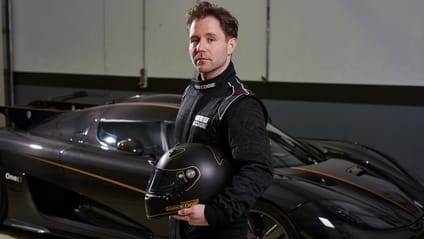
Man vs machine: flat out in the Koenigsegg One:1
The latest exhilarating Castrol Titanium Trial features two remarkable men in two remarkable machines: Aston Martin factory driver, Darren Turner, in the ultra rare Aston Martin Vulcan; and Denmark’s Christoffer Nygaard in the even rarer Koenigsegg One:1

{"fid":"496411","view_mode":"wysiwyg","fields":{"format":"wysiwyg","field_media_video_duration[und][0][value]":"50"},"type":"media","link_text":null,"attributes":{"alt":"Castrol EDGE Clone Rival – The Trailer","height":428,"width":760,"class":"media-element file-wysiwyg"}}
This fourth Titanium Trial – called Clone Rival – is arguably Castrol’s most ambitious instalment yet. Unequivocally, it’s the fastest. The aim of the ground-breaking challenge was always to push the limits of driving performance, testing the driver, the car, and – crucially – Castrol EDGE like never before.
For over 115 years, Castrol has been driven by a restless spirit of innovation and this determination to push the boundaries of what is possible - with the constant goal of developing the best engine oils. It is this thrill, and the excitement of creating and redefining what is possible that drives everything Castrol does.
Advertisement - Page continues below
Christoffer Nygaard is a 30-year old Danish racing driver with a winning record in both European one-make racing (VW Polo Cup, SEAT Leon Supercoppa) and international GT championships. These days, his day job might best be described as ‘the stuff that dreams are made of’. When he isn’t racing, Nygaard is the official test driver for Swedish hypercar firm Koenigsegg. Yes, he gets paid to travel the world, testing and developing cars like the ferocious One:1...
There are only six Koenigsegg One:1s in the world, which easily makes it one of the most sought after cars on the planet. It hardly needs saying, but it is also one of the fastest and most powerful. And, of course, there is only one Christoffer Nygaard. Together, the perfect combination for Castrol EDGE and Clone Rival.

The choice of Nygaard and the One:1 provided Castrol with a perfect man and machine with which to put the latest Castrol EDGE oil to the test. The name of this fourth Titanium Trial – Clone Rival – is no superficial marketing moniker. It is a wholly accurate description of the challenge that Christoffer faced. The only person, perhaps, he might fear going head-to-head with: a digital, virtual reality clone of himself.
The challenge began in a lab, in a ground-breaking virtual reality simulator. A combination of advanced digital race simulation and sophisticated human biometrics allowed Castrol to accurately data-map Nygaard as he ‘virtually’ drove the exclusive Spanish race track, Ascari, one of the most challenging circuits in the world.
And then, the man Koenigsegg chose to test its multi-million pound hypercars was sent out onto the track for real, to find out if he could beat the virtual reality version of himself.
Advertisement - Page continues below
A lap of Ascari is long. At 3.7 miles, it is the same sort of length as a contemporary Formula One circuit, and it features 25 highly demanding, technically challenging turns, elevations and camber changes. It is notoriously difficult to memorise and to master. Even a simulator as sophisticated as that used to map Christoffer’s virtual lap cannot replicate the visceral physicality of the real thing. Hit the wall or miss a gear on a VR rig and you simply hit reset, and go again. Do it for real on a race track and, at best, it’s an expensive mistake. At worst, you may not get another go...
But challenges are what bring the best out of any real race driver. “I always knew that being confronted by my ultimate best potential was going to be tough. I pushed myself harder than I might against any other rival. Beating my digital clone became my sole objective...”

And what about the car Nygaard would be using to take himself on? One of only six ever made, the Koenigsegg One:1 looks and sounds like it still belongs in the future, the barely believable realisation of every petrolhead’s fantasy. Beneath that minacious, black carbon fibre bodywork sits a 5.0-litre, twin-turbocharged, V8 engine with a power output that, at first glance, looks like a typing mistake: 1,341 bhp (1,361PS).
Except it isn’t. This Koenigsegg develops the same amount of power as 10 MINI Coopers. This astonishing power output is also where the car gets its name from. A Koenigsegg One:1 weighs just 1,361kg, giving it a power-to-weight ratio of one PS to one kilogram. That is equivalent to one megawatt which, according to Koenigsegg, makes the One:1 the world’s first ‘megacar’.
Mega, hyper, super – what’s the difference? Back in the real world, it means the One:1 reaches the benchmark 62mph in just 2.8 seconds.

Creating the two films that make up Castrol’s fourth Titanium Trial took a level of commitment to match the capabilities of the cars, drivers and – of course – Castrol EDGE itself. As described, this is the fastest Trial ever, with the two featured drivers – Christoffer Nygaard in the Koenigsegg One:1 and Aston Martin test and race driver, Darren Turner, in a Vulcan – reaching top speeds of over 170mph around Ascari.
But filming that action is no mean feat. Every aerial shot in Clone Rival was captured from a helicopter – even the most advanced drone in the world would not have been fast enough to keep up with the cars. On-track action demanded the world’s leading ‘Russian Arm’ filming car, with a gyro-stabilized, 360º panning camera fitted to a car capable of getting as close as possible to the speeds that the Koenigsegg and Aston Martin are capable of.
When you see the film, we believe you’ll see how the means justified the end...
Featured

Trending this week
- Car Review
BMW 1 Series




